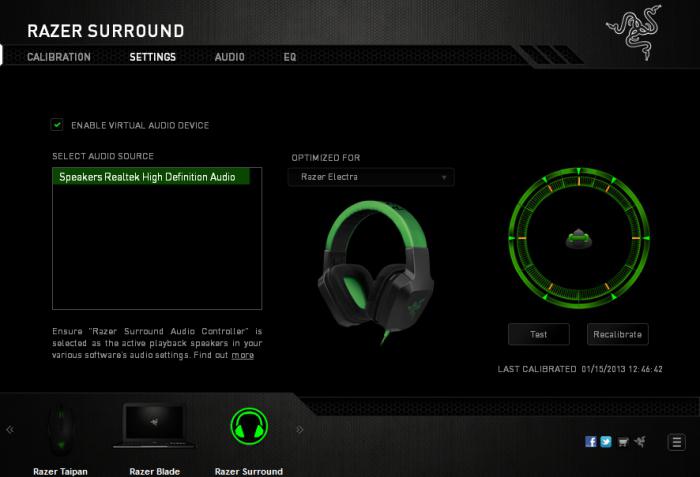One of the questions that sooner or later almost every user of a fixed personal or mobile computer- this is "how to increase the volume of the headphones." It may seem that if the speakers are located directly on the ears, then the problem of too quiet sound cannot exist. Alas, it is not. Forums on the global Web are full of topics "how to increase the volume of headphones on a computer." Often there are quite acceptable recommendations, but sometimes they come across completely impractical. Today we will talk about how you can increase the volume of your headphones in ways accessible to everyone.
Sound shaping
Perhaps no one will argue with the fact that you need to understand why the sound is limited (and whether it actually exists), and only then use any solution. So in this case - before you figure out in practice how to increase the volume of the headphones, you should remember the theory. Sound is air vibrations of a certain frequency.  To reproduce the sound stream, various solutions are used: from the simplest, like a regular whistle, to universal dynamic heads (speakers). The latter are just used to generate a stream consisting of various frequencies. Large and small speakers, as well as headphones, basically contain such devices. A stationary magnet creates a constant field. A movable membrane is placed next to it, combined with a coil through which an alternating current of the desired frequency passes. Since when it occurs, its own field is generated in the coils, their interaction occurs and the membrane is attracted / repelled, creating air vibrations, that is, sound.
To reproduce the sound stream, various solutions are used: from the simplest, like a regular whistle, to universal dynamic heads (speakers). The latter are just used to generate a stream consisting of various frequencies. Large and small speakers, as well as headphones, basically contain such devices. A stationary magnet creates a constant field. A movable membrane is placed next to it, combined with a coil through which an alternating current of the desired frequency passes. Since when it occurs, its own field is generated in the coils, their interaction occurs and the membrane is attracted / repelled, creating air vibrations, that is, sound.
How to increase the headphone volume?
 Thus, several parameters affect the volume at once.
Thus, several parameters affect the volume at once.
- current strength in turns, which is determined by the characteristics of the sound card amplifier (the greater the current, the stronger the field and the greater the shift of the cone);
- the value of the electrical resistance of the coil in the membrane;
- contact resistance in connectors;
- the capabilities of the membrane itself (diffuser).
So how do you turn up the headphone volume? Obviously one of the most simple ways is to increase the current. It can be done programmatically and by making changes to the hardware. Since not everyone can solder transistors, we do not consider the latter. To raise the sound in operating system Windows, you need to click the left mouse button once on the speaker image in the lower right corner of the desktop (where the clock is). The higher the slider, the louder the sound. In fact, this is a software control of the gain of a sound card, or, which is also true, an increase in current strength. Note that if wheezing and frequency cuts have begun in the sound stream, this means that the diffuser is physically unable to move a greater distance (shift the air mass) and further increase in volume is not recommended to save it from damage. If the sound is “clear”, but quiet, then you can try using programs that can further amplify the signal. For video, this is PotPlayer - in its settings you need to set the gain when decoding DTS / AC3 and raise the mixing levels. In the well-known Winamp, you can recommend choosing WaveOut (rather than Direct Sound) as the playback device. The menu window appears when you press the Ctrl + P combination in the application. Sometimes soft zoom does not give the desired results. The reason is the lack of matching of the output stage of the amplifier and the resistance of the speaker coil in the headphones. For example, if the amplifier is designed to operate with a load of 4 ohms, and this model headphones has an impedance of 32 ohms. The solution is one - replacement with another model. Sometimes a simple cleaning with fine sandpaper (zero) of the connector with which the headphones are connected to the sound card helps.
I think I'm not lying if I say that most users are faced with a similar problem! Moreover, sometimes it is not so easy to solve it: you have to install several versions of drivers, check the speakers (headphones) for operability, and make the appropriate settings for Windows 7, 8, 10.
In this article, I will focus on the most popular reasons why the sound on the computer may be quiet.
1. By the way, if you have absolutely no sound on your PC, I recommend that you read this article: /i>
2. If your sound is quiet only when watching a particular movie, I recommend using the special. program to increase the volume (or open in another player).
Poor contact connectors, non-working headphones/speakers
Pretty common reason. This usually happens with "old" PC (laptop) sound cards, when various sound devices have already been inserted / removed hundreds of times into their connectors. Because of this, the contact becomes bad and as a result you observe quiet sound…
I have on home computer there was exactly the same problem as the contact went away - the sound became very quiet, I had to get up, go to system unit and fix the wire coming from the speakers. I solved the problem quickly, but “clumsily” - I just glued the wire from the speakers to the computer table with tape so that it would not hang out and move away.
By the way, many headphones have an additional volume control - pay attention to it as well! In any case, with a similar problem, first of all, I recommend starting with just checking the inputs and outputs, wires, the performance of headphones and speakers (for this you can connect them to another PC / laptop and check their volume there).
Are the drivers normal, do you need an update? Are there any conflicts or errors?
Approximately half software problems with the computer associated with the drivers:
- errors of driver developers (usually they are fixed in newer versions, which is why it is important to check for updates);
- incorrectly selected driver versions for this Windows OS;
- driver conflicts (most often this happens with various multimedia devices. For example, I have one TV tuner that did not want to “transmit” sound to the built-in sound card, it was impossible to do without tricky tricks in the form of third-party drivers).
Driver update:
How to find out the characteristics of the PC (you need to choose the right driver):
2) Also a good option would be to use special. utilities for updating drivers. I talked about them in one of my previous articles:
3) You can also check the driver and download the update in Windows 7, 8 itself. To do this, go to the "Control Panel" of the OS, then go to the "System and Security" section, and then open the "Device Manager" tab.

In Device Manager, open the "Sound, video and game controllers" list. Then you need to click right click mouse on the sound card driver and in context menu select "Update Drivers...".
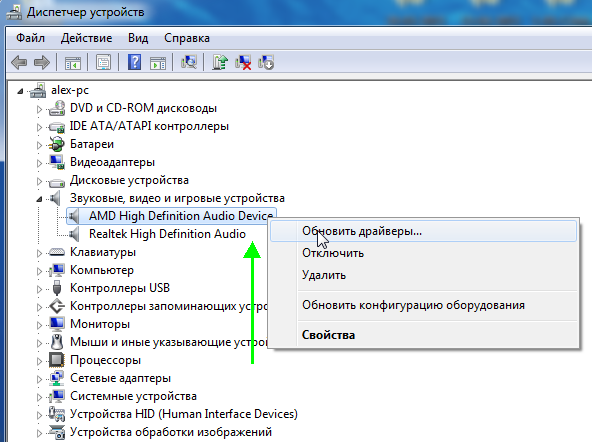
Important!
Please note that in the device manager there are no exclamation marks (neither yellow nor red ones) opposite your audio drivers. The presence of these signs, as in the screenshot below, indicates conflicts and driver errors. Although, most often, with such problems, there should be no sound at all!

How to increase the volume in Windows 7, 8
If there are no hardware problems with the headphones, speakers and PC, the drivers are updated and in order, then 99% of the quiet sound on the computer is related to the Windows OS settings (well, or to the settings of all the same drivers). Let's try to adjust both, thereby increasing the volume.
2) The second step is to check the sound volume by clicking on the tray icon (next to the clock). If necessary, move the slider up, thereby increasing the volume to the maximum!
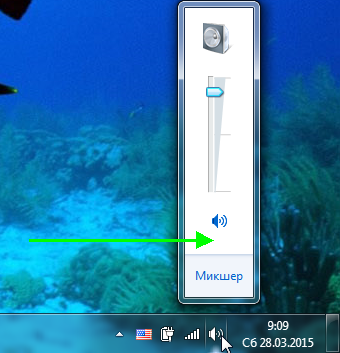
3) For fine tuning volume, go to the panel Windows controls, then go to the Hardware and Sound section. In this section, we will be interested in two tabs: “volume adjustment” and “sound device control”.
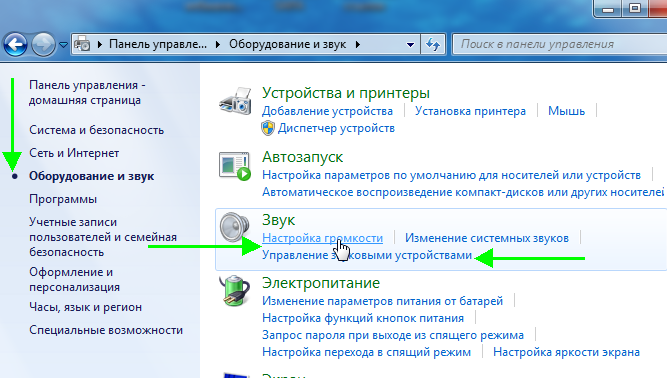
4) In the "volume settings" tab, you can adjust the volume of the playback sound in all applications. I recommend for now just raise all the sliders to the maximum.

5) But in the "Management of sound devices" tab, everything is more interesting!
Here you need to select the device through which your computer or laptop plays sound. As a rule, these are speakers or headphones (the volume slider will probably run next to them
If you have something playing in this moment).
So, you need to go to the properties of the playback device (in my case, these are speakers).
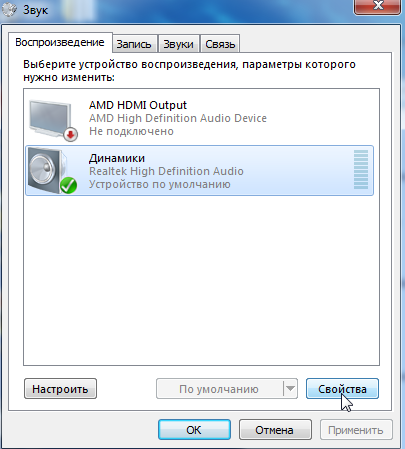
- levels: here you need to move the sliders to the maximum (levels are the volume level of the microphone and speakers);
- special: uncheck the box next to "Limited output" (you may not have this tab);
- improvement: here you need to check the box next to the "Loudness" item, and uncheck the rest of the settings, see the screenshot below (this is in Windows 7, in Windows 8 "Properties -\u003e additional features -\u003e volume equalization" (tick)).

If nothing helps - still a quiet sound ...
If all the recommendations above have been tried, and the sound has not become louder, I recommend doing this: check the driver settings (if everything is OK, then use special program to increase the volume). By the way, spec. the program is also convenient to use when the sound is quiet when watching a particular movie, and in other cases there are no problems with it.
1) Checking and configuring the driver (on the example of Realtek)
It's just that Realtek is the most popular, and it's the one installed on my PC, on which I'm currently working.
In general, the Realtek icon is usually displayed in the tray, next to the clock. If you do not have it, like me, you need to go to the Windows control panel.
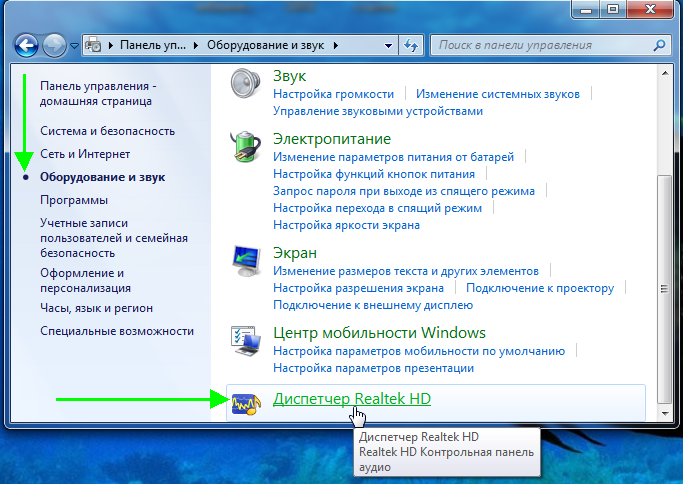

2) The use of special programs to increase the volume
There are programs that can increase the playback volume of a particular file (and indeed the sounds of the system as a whole). I think many have come across the fact that no, no, yes, and there are “crooked” video files that have a very quiet sound.
Alternatively, you can open them with another player and turn up the volume in it (for example, VLC allows you to turn up the volume above 100%, in more detail about the players: ; or use sound booster(For example).
sound booster
Official site: www.letasoft.com/

What the program can do:
- increase the volume: Sound Booster easily boosts the sound volume up to 500% in programs such as web browsers, communication programs (Skype, MSN, Live and others), as well as in any video or audio player;
- easy and convenient volume control (including using hot keys);
- autostart (can be configured so that when Windows startup- Sound Booster was also launched, which means you will not have problems with sound);
- there is no sound distortion, as in many other programs of this kind (Sound Booster uses great filters that help preserve almost the original sound).
That's all for me. How did you solve the volume problems?
By the way, one more a good option— buy new speakers with powerful amplifier! Good luck!
Wanting to view family video archives stored on a PC hard drive, you suddenly find that the soundtrack has disappeared. If you take into account that your user knowledge is initial, then you can imagine how difficult this situation is for you. Of course, you don’t even know how to make sound on a computer, and worldly experience only suggests that it may correct the situation. However, it was not there. Well, let's look at the main ways to restore sound. After all, in this case silence is far from golden!
Where to look for the reason?
Perhaps careless file manipulation led to the removal of the sound driver. It is likely that the machine code that controls the voice acting "flew" spontaneously. The hardware part of the computer, and in particular, could well fail. Recently installed program may also turn out to be "the initiator of the game of silence." Finally, the culprit of computer "muteness" may well be malicious virus. And that's not all possible reasons, due to which many users have the question “how to make sound on a computer”. From now on, let's consider the situation in more detail and with the following conclusions.
Banal inattention
In the service room, on the right, there is an icon of the sound level. In the case when the displayed "speaker" frames the prohibitory sign, it is necessary to move the slider up. Again, the crossed out symbol in the form of an X means a malfunction of the sound device, that is, the driver may have crashed. Make sure that system sounds included. It is worth noting that the silence of the speakers during video playback is often expressed by the absence of multimedia codecs. In this case, it is recommended to install the complex package " K-Lite Codec Pack". The installation process will require only a few clicks on the "Next" button. However, there are enough opportunities and options on how to make sound on a computer.
Device Manager - Fault Beacon
You need to make sure that sound driver recognized by the system as a correctly functioning software component.
- Go to the start menu and navigate to the control panel.
- Open "System" and activate the item "Device Manager".
- In the window that opens, none of the items, and in particular "Sound ...", should not be marked with a red cross or an exclamation mark.
- On the corresponding speaker icon, right-click, call and click on the "Properties" designation.
- Pay attention to the window diagnosing the state of the device. Usually, the operating mode is indicated by the line "...working normally."
- Otherwise, you need to reinstall the sound driver, after removing the faulty component.
If the above method did not bring an effective answer to the question "how to restore sound on a computer", proceed to the next step in troubleshooting.
Visual inspection of the computer
So, first of all, you need to check the technical condition of the speakers, the position of the cords relative to the corresponding audio input jacks, and also make sure that the sound card itself is working.
- Mobile phones as well as TVs and DVD players are equipped with a 3.5 mm jack. It will not be difficult for the user to connect the speakers to any multimedia device in order to check for performance.
- Connecting wires and plug-in terminations can also be damaged due to internal breaks and mixing. It is recommended to use ordinary headphones in order to compare the test results.
- If your PC does not have an integrated sound card, make sure that the "melodic" module installed in the PCI is installed correctly, and the device is properly positioned in the slot.
- The ideal option is to "throw" a known working sound card.
How to make sound on a computer: BIOS settings
If your motherboard has an integrated one, it's worth going into the BIOS and viewing the audio device settings.
- After turning on or rebooting, press the "del" or "F2" key several times.
- Depending on the type of your BIOS, the sound device parameters may be displayed in different tabs. However, it is most likely that you will find the item you are looking for in the Advanced menu.
- It is likely that the “disabled” parameter is in front of the device responsible for the sound. Changes can be achieved by pressing the "enter" key, set the value to "enabled". Perhaps in this way you will receive the long-awaited answer to the question of how to restore sound on a computer.
- Save the corrected version of the settings and restart your computer.
If you managed to "talk numb electronics", it makes sense to programmatically improve the sound device.
Review of the most acceptable software solutions: "Razer Surround"
The presented aggregator will allow you to improve the sound on your computer. It is worth noting that the software is sharpened for gaming applications. However, this inconvenience does not affect the use in a multifaceted application.
- Install the downloaded software on your PC and run it.
- Complete a short registration and enjoy an incredibly effective sound management tool.
"Volume"
The name of the program speaks for itself. The installed application allows you to qualitatively increase the comfort of managing playback parameters. One of the advantages of the software can be considered the implemented ability to assign "hot" keys. In other words, the effective sound setting on the computer is the "Volume" program. 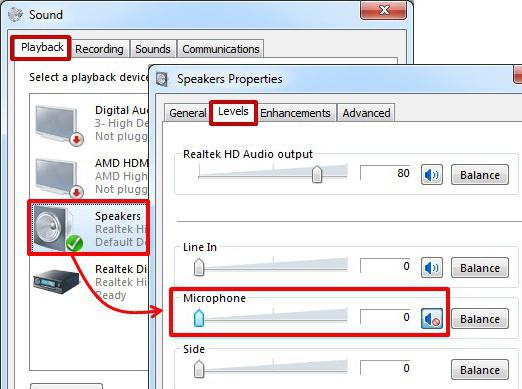
Of course, the software mentioned above is absolutely free. The only limitation ("Razer Surround") may be the lack of hardware capabilities of the computer to reproduce 7.1 multi-channel audio.
Finally
Connecting sound on a computer, in general, is not a tricky business. However, given the existence of incredibly complex audio circuits, the user may encounter some difficulties. However, if you are reading this article, most likely, it will not be difficult for you to find a solution to all the "incomprehensible" problems, including connecting various equipment. Melodic realizations to you!




